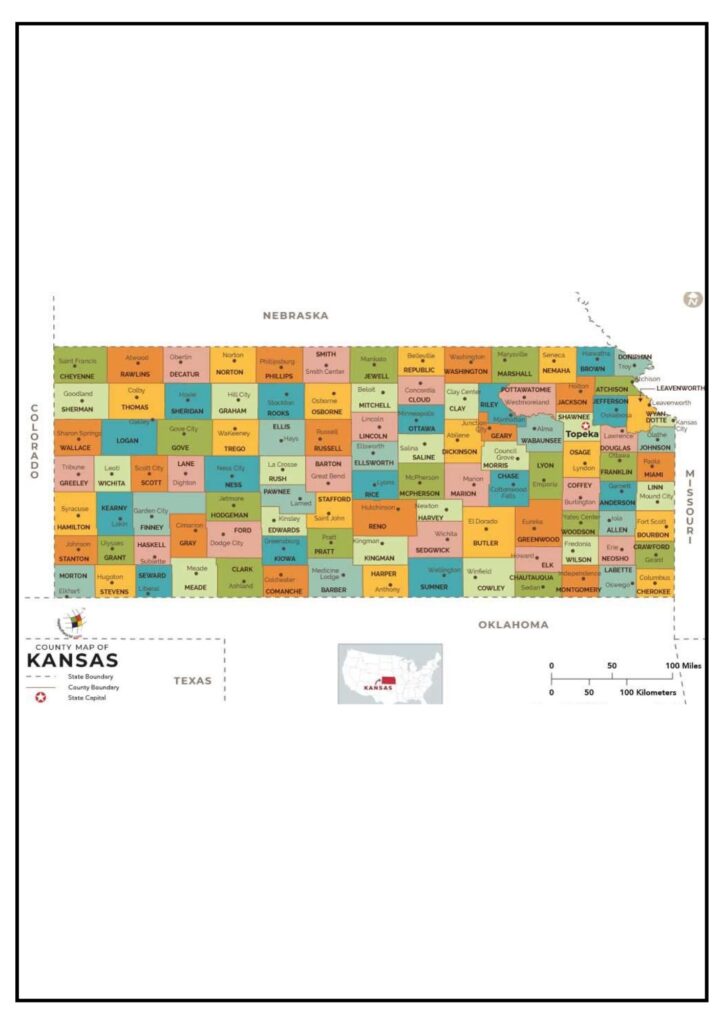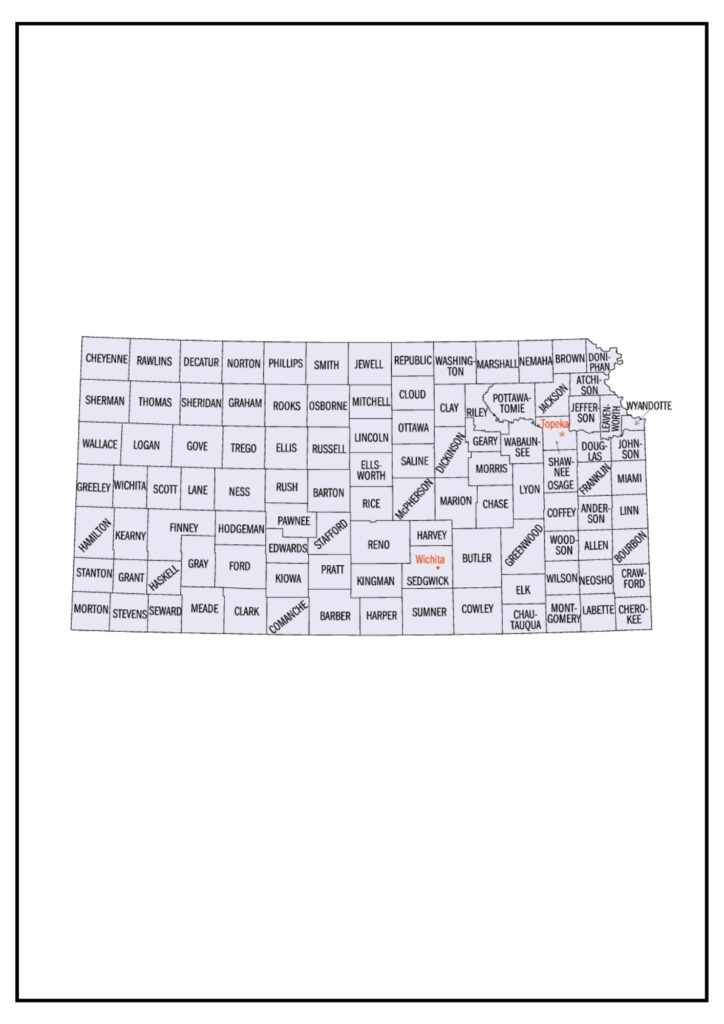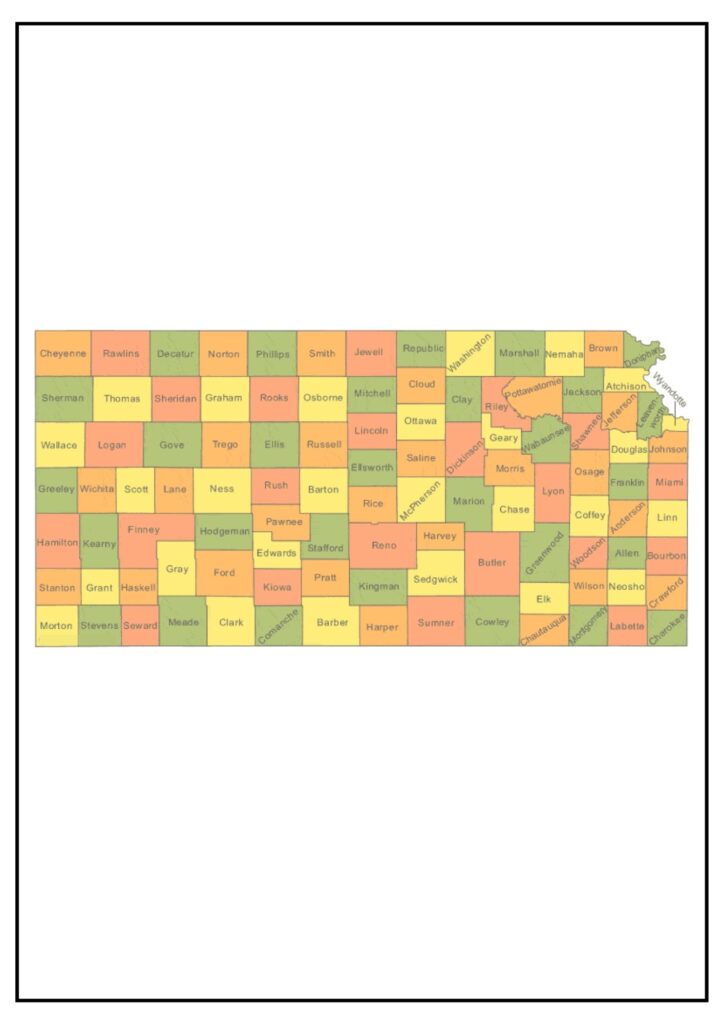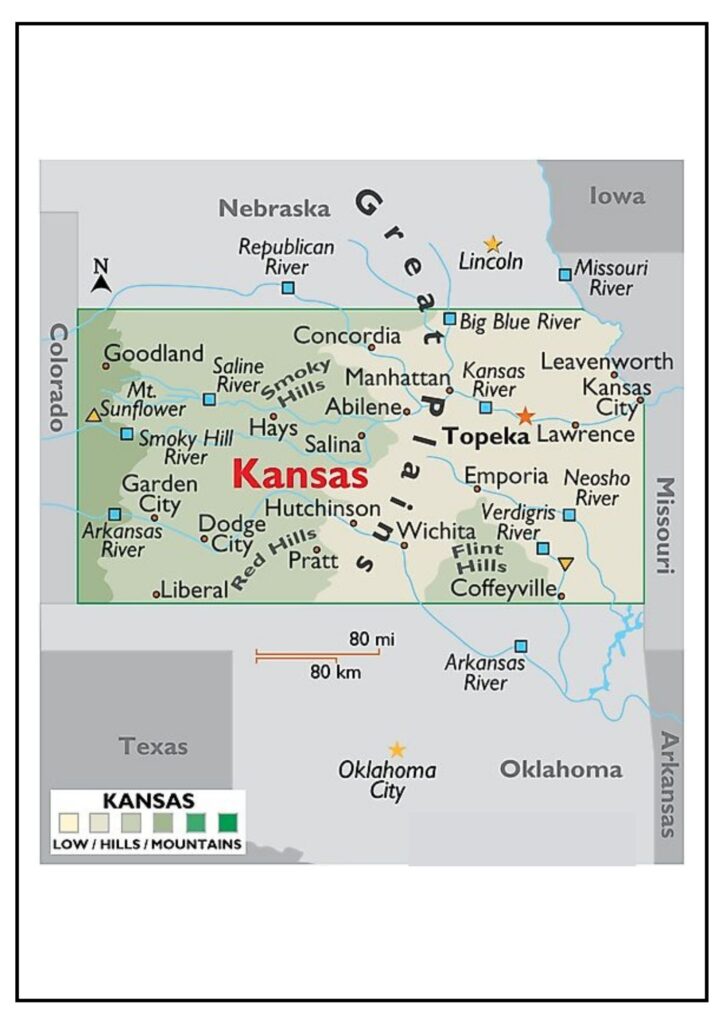Kansas County Map : The Sunflower State (Kansas), is located in the center of the United States of America. Kansas is the 15 largest U.S. state, by land area, and it is also the 34 th most populated. The state of Kansas was critical in determining the result of the American Civil War. pi-Ill proand anti-slavery groups fought bitterly within the state.
Related Post –
- Kentucky County Map
- Minnesota County Map
- Arizona County Map
- Illinois County Map
- Pennsylvania County Map
Kansas County Map [KS Counties Map]

The Kansas County detailed Map is a useful tool defining the state situation in terms of its population distribution. It shows the location of all 105 counties in Kansas and emphasizes their county座位s. It also outlines major roads and rivers in the state.<<
You can use the Kansas County Map for a number of reasons such as:
- Planning a trip: It can help you to plan your route and to identify important sights in the course of your travels.
- Researching a county: The map gives information on the size of a county, its population, and the leading economic sectors in the county.
- Comparing counties: From the map, you are able to easily identify and compare counties in terms of size, population and loca, sites.
If you want to learn more about the state, Kansas County Map will be a helpful guide.
Kansas Map with Counties and Cities
All of Kansas’s 105 counties, including their respective municipalities, major urban cities, can easily be identified on the map.
Some further observations about the Kansas Map featuring Counties and Cities:
- It is evident from the map that Kansas is large in size and diverse in characteristic. The size of counties is very different with Wyandotte County (which takes up just over 12 square miles) and Butler County, which extends several hundred miles (covering more than 1,400 square miles). There are ranges of the population living in the counties in a given state with that of Johnson County being over 600,000 while that of some rural counties is below 10 000.
- The map manifests that most of Kansas is rural areas. Wichita the largest city in Kansas has a population of about 380000. Next come the three largest cities with overland park followed by Topeka and then Kansas City Kansas with populations under 250,000.
- The map contains a prominent position for agriculture as one of Kansas’s major industries. Agriculture is very important in Kansas and the state is renowned for producing wheat, corn, soybeans and sunflowers. The production of agriculture is of great importance in most of the counties found in western Kansas.
- The map also reveals that Kansas is famous for its historical landmarks including; the Dwight D. Eisenhower Presidential Library and Museum, the Boot Hill Museum, and the Tallgrass Prairie National Preserve.
Johnson County Kansas Map
It outlines the location of all 18 cities in Johnson County, major roads, rivers and parks.
Moreover, below are some extra observations for the Johnson County Kansas Map:
- Johnson County is flat in shape, covering an approximate total area that is about 476 square miles (on the map). Although small in term of size, the county has a huge population of more than 600, 000 people.
- Johnson County differentiates itself by its advanced development as shown in the map. Several high-profile corporates and businesses are situated in the county, alongside famous schools and universities.
- As shown on the map, Johnson County is diverse. County residents are from all states and countries in the world.
- Johnson County is described as a beautiful county on the map. The county is made up of various parks and recreation sites surrounded by diverse types of natural settings.
One of the most useful resources for getting a better idea of Kansas is the Kansas County Map.
You can see the breakdown of Kansas counties on the map below:
Total Number of Counties:
- Kansas is among the-states with large number of counties with its 105 counties.
Geographic Distribution:
- The pattern of distribution of the counties is uniform in nature, particularly in the central and west region, where the grid system stands out most. Systematic arrangement is directly caused by massive reliance on agricultural activities by the state and the implementation of the Homestead Act.
Major Counties:
- Johnson County: One that exists in the northeastern part qualifier Kansas City metropolitan region and has the largest population within the state.
- Sedgwick County: South-central Kansas is home to this county where we find Wichita, Kansas’s most populous city, and a county that plays a mighty economic role.
- Shawnee County: The county houses the state capital, Topeka, and is located at the centre of the northeastern part of Kansas.
- Wyandotte County: Also in the northeast it includes Kansas City, Kansas and is part of greater Kansas City metropolitan area.
Regional Characteristics:
- Eastern Kansas: Areas such as Douglas and Leavenworth are more densely populated where you can have rolling hills, river valleys and a fertile economic base.
- Central Kansas: In Saline and Riley Counties, agricultural land and urban centers, as well as significant educational and military institutions (Kansas State University and Fort Riley), are adjacent to each other.
- Western Kansas: The latter includes counties like Finney and Ford that have expansive flat plains dotted among their agricultural sectors that predominantly are wheat and cattle-based.
Topographical Features:
- Flint Hills: In counties like Chase and Geary this region is made distinct by its high grass prairies and undulating hills and it saves some of the last unspoilt tallgrass landscapes in the United States of America.
- Smoky Hills: With Ellsworth and Lincoln county being some of the counties along the path, this portion of Kansas has rolling topography and occasional limestone exposures.
- High Plains: This region is in the most western counties in the state such as Greeley and Sherman and it belongs to the larger Great Plains and is marked with a dry, large region.
Major Rivers:
- Kansas River: Marries key northeastern counties such as Shawnee, Douglas and Wyandotte and is an important water resource for the region.
- Arkansas River: It traverses Sedgwick and Finney, among others, which are crucial for water supply important for agriculture and industries at large in Southern Central and South Western counties.
Population Density:
- High Population Density: Northeast counties of Johnson, Wyandotte, and Sedgwick which are known to have higher densities due to urban spread and proximity to the large urban areas stand out.
- Low Population Density: The population densities are much lower in the western part of Kansas including places like Wallace and Hamilton because the area is not densely populated and is rurally based and agricultural.
Economic Activities:
- Agricultural Counties: Several central and western counties including McPherson and Scott base most of their economic livelihood on agriculture with major items being wheat, corn and Cattle.
- Urban and Suburban Counties: The Johnson and Sedgwick counties differ economically in their diversity with major industries including manufacturing, healthcare, finance, and education.
Transportation and Infrastructure:
- Interstate Highways: Major interstates like I-70 and I-35 run through counties such as Wyandotte, Douglas, and Dickinson, connecting Kansas to its bordering states and facilitating transportation and commerce.
- Railways: Railroads cover the state, particularly central and western counties, serving agriculture and manufacturing sectors.
Historical Significance:
- Historical Counties: Certain counties, such as Douglas (Lawrence’s location) and Atchison, are historically relevant to the Bleeding Kansas dispute prior to the Civil War and westward expansion.



